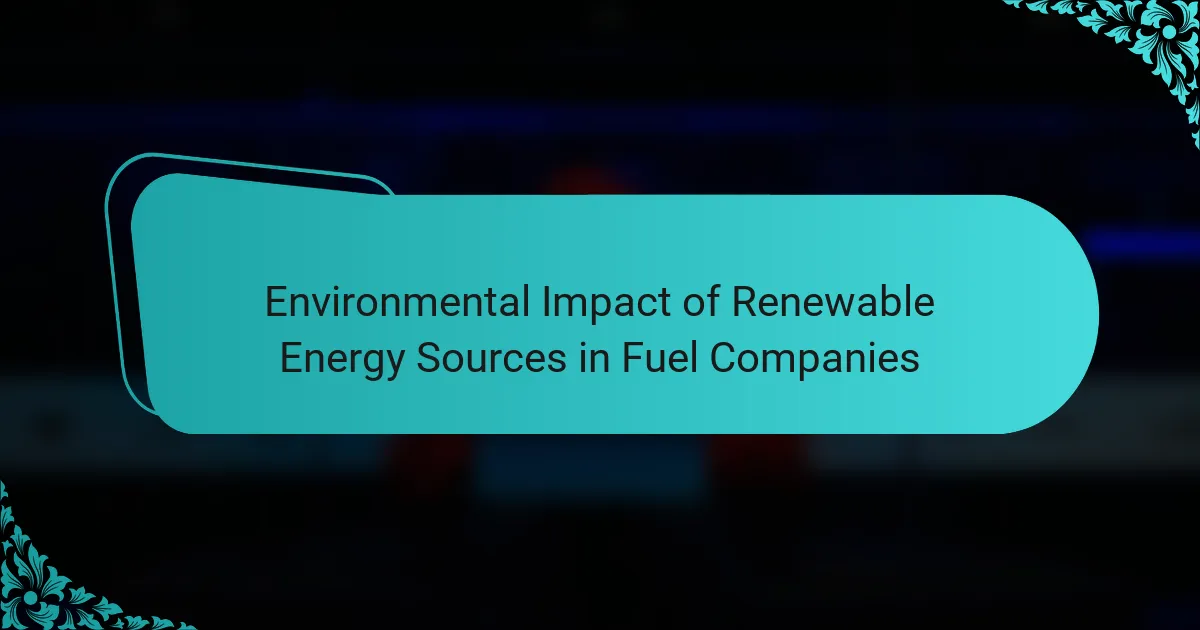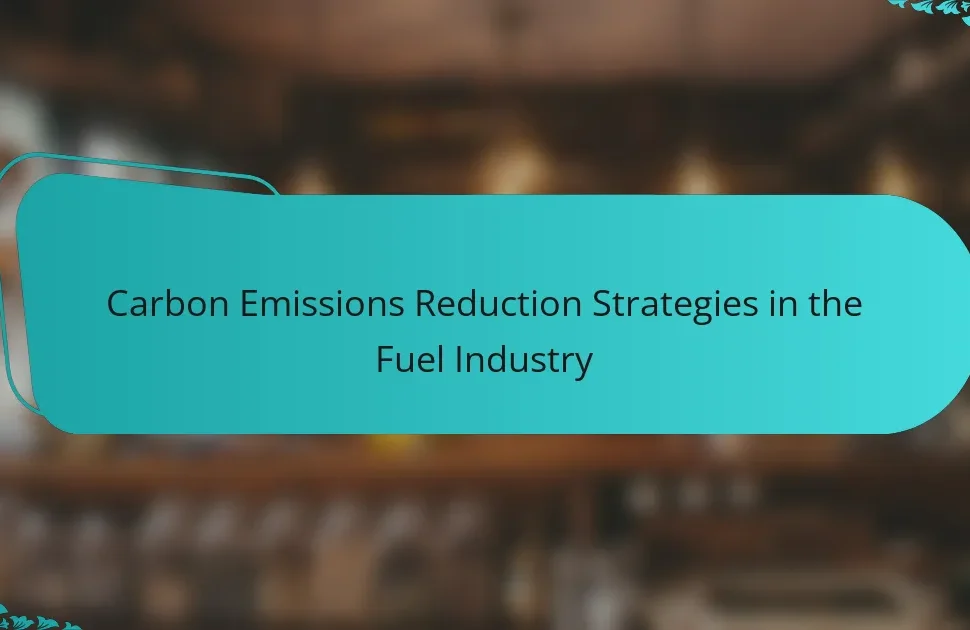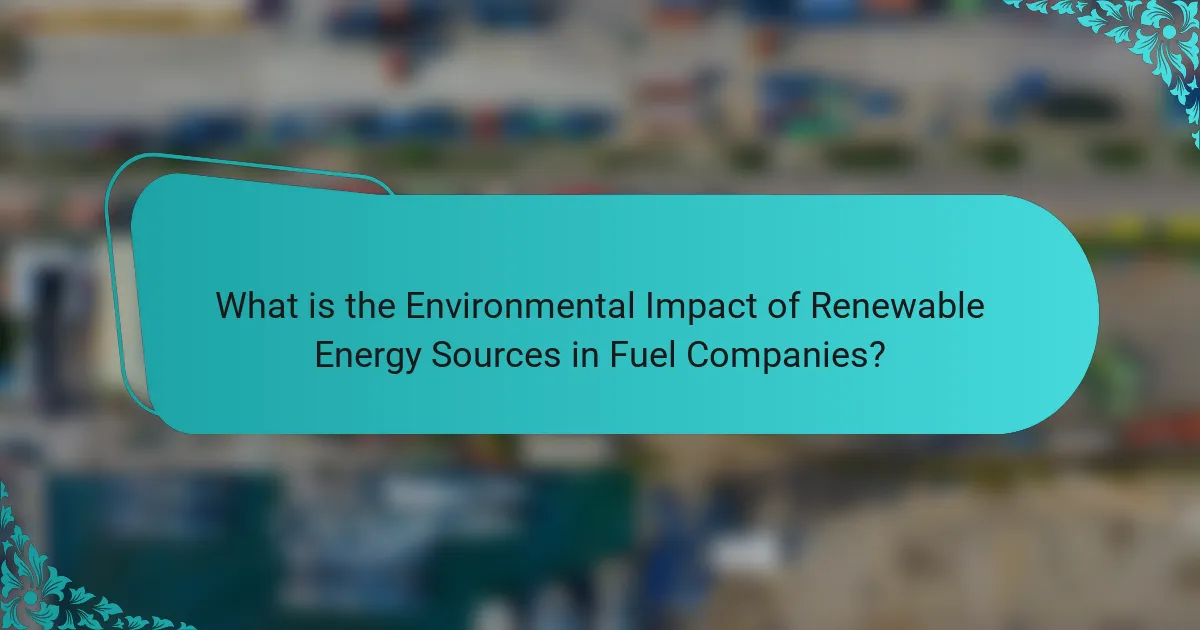
What is the Environmental Impact of Renewable Energy Sources in Fuel Companies?
Renewable energy sources significantly reduce the environmental impact of fuel companies. They lower greenhouse gas emissions compared to fossil fuels. For instance, wind and solar energy produce minimal emissions during operation. This transition helps mitigate climate change effects. Additionally, renewable energy reduces air and water pollution. According to the International Renewable Energy Agency, renewables can cut carbon emissions by up to 70% by 2050. Implementing these sources also decreases dependence on finite resources. Fuel companies adopting renewables can enhance sustainability and improve public health outcomes.
How do renewable energy sources contribute to reducing environmental harm?
Renewable energy sources significantly reduce environmental harm by minimizing greenhouse gas emissions. Unlike fossil fuels, renewable sources like solar, wind, and hydroelectric power produce energy without releasing carbon dioxide or other harmful pollutants. According to the International Renewable Energy Agency, transitioning to renewables could reduce global CO2 emissions by up to 70% by 2050. Additionally, renewable energy reduces air and water pollution, which are major contributors to health problems and ecosystem degradation. For instance, the U.S. Environmental Protection Agency reports that renewable energy can lower sulfur dioxide and nitrogen oxide emissions. This transition also decreases reliance on finite resources, promoting sustainability and reducing habitat destruction linked to fossil fuel extraction.
What specific renewable energy sources are utilized by fuel companies?
Fuel companies utilize several specific renewable energy sources. These include biofuels, solar energy, wind energy, and hydropower. Biofuels are derived from organic materials like plants and waste. They can be used in transportation fuels. Solar energy harnesses sunlight through photovoltaic cells to generate electricity. Wind energy captures wind movement using turbines to produce power. Hydropower generates energy by using flowing water to turn turbines. These sources contribute to reducing greenhouse gas emissions and reliance on fossil fuels. The integration of these renewable sources is essential for sustainable energy practices in the fuel industry.
How do these sources compare to traditional fossil fuels in terms of emissions?
Renewable energy sources generally produce significantly lower emissions compared to traditional fossil fuels. For instance, solar and wind energy emit no direct greenhouse gases during operation. In contrast, fossil fuels release carbon dioxide and other pollutants when burned. According to the U.S. Energy Information Administration, coal-fired power plants emit approximately 2,200 pounds of CO2 per megawatt-hour. In comparison, renewable sources like wind and solar have lifecycle emissions that are 80-90% lower than coal. This stark difference highlights the environmental advantages of transitioning to renewable energy.
What are the potential benefits of integrating renewable energy in fuel companies?
Integrating renewable energy in fuel companies can lead to significant environmental and economic benefits. Firstly, it reduces greenhouse gas emissions, thereby mitigating climate change. According to the International Renewable Energy Agency, transitioning to renewables can decrease carbon dioxide emissions by up to 70%. Secondly, renewable energy sources, such as solar and wind, can provide energy security and reduce dependence on fossil fuels. This transition can also result in cost savings over time, as renewable technologies often have lower operational costs. Additionally, integrating renewables can enhance a company’s public image and attract environmentally conscious consumers. Investing in renewable energy can also create job opportunities in new sectors. Overall, the integration of renewable energy promotes sustainability and aligns with global energy trends.
How does renewable energy use affect carbon footprints?
Renewable energy use significantly reduces carbon footprints. By replacing fossil fuels, renewable sources like solar and wind generate electricity without carbon emissions. According to the International Renewable Energy Agency, renewable energy can cut global greenhouse gas emissions by up to 70% by 2050. This transition leads to cleaner air and mitigates climate change effects. Additionally, using renewable energy enhances energy efficiency, further decreasing overall emissions. In 2020, the U.S. saw a 10% drop in carbon emissions due to increased renewable energy adoption. Thus, the shift to renewable energy is critical for reducing carbon footprints effectively.
What economic advantages do fuel companies gain from renewable energy sources?
Fuel companies gain economic advantages from renewable energy sources through cost savings and diversification. Renewable energy often has lower operational costs compared to fossil fuels. For example, the cost of solar energy has decreased by over 80% since 2010. This reduction allows fuel companies to invest in cleaner technologies while maintaining profitability.
Additionally, renewable energy sources can provide energy security and reduce dependency on volatile fossil fuel markets. Companies that diversify into renewables can also access government incentives and subsidies. These financial benefits can enhance profit margins.
Moreover, investing in renewable energy can improve a company’s public image. This positive perception can attract environmentally conscious consumers and investors. As a result, fuel companies can tap into new markets and revenue streams.
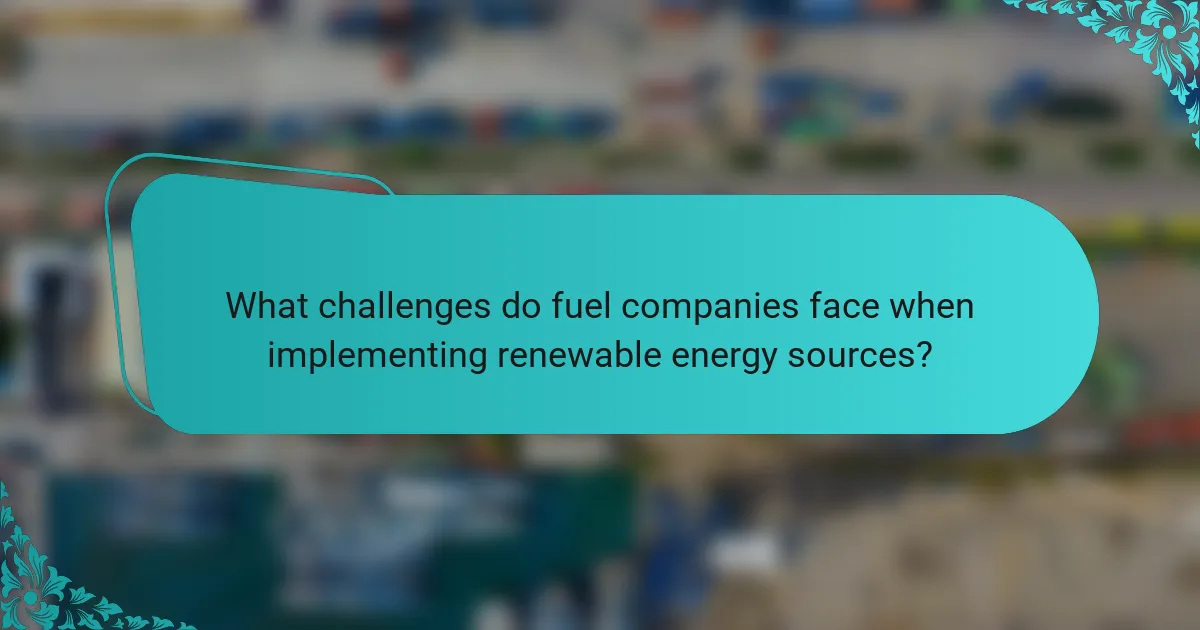
What challenges do fuel companies face when implementing renewable energy sources?
Fuel companies face several challenges when implementing renewable energy sources. These challenges include high initial investment costs. Transitioning to renewable technologies often requires significant capital expenditure. Additionally, there are regulatory hurdles that vary by region. Navigating these regulations can be complex and time-consuming.
Supply chain issues also pose challenges. Securing consistent and reliable sources of renewable materials can be difficult. Furthermore, there is a need for technological adaptation. Existing infrastructure may not be compatible with new renewable systems.
Market volatility can impact the feasibility of renewable investments. Fluctuating prices for traditional fuels may deter companies from committing to renewables. Finally, there is public perception and acceptance to consider. Stakeholder buy-in is crucial for successful implementation.
What are the technological barriers to adopting renewable energy?
Technological barriers to adopting renewable energy include high initial costs, limited energy storage solutions, and outdated infrastructure. High initial costs often deter investment in renewable technologies. For instance, solar and wind installations require significant upfront capital. Limited energy storage solutions hinder the reliability of renewable sources. Current battery technologies may not efficiently store energy for long periods. Outdated infrastructure complicates the integration of renewable energy into existing power grids. Many grids were designed for fossil fuels, making them less compatible with variable renewable sources. Additionally, technological standardization remains a challenge. Different renewable technologies may lack compatibility, complicating widespread adoption. These barriers collectively slow the transition to renewable energy sources.
How do infrastructure limitations impact the transition to renewable energy?
Infrastructure limitations significantly hinder the transition to renewable energy. Insufficient grid capacity restricts the integration of renewable sources like wind and solar. Aging transmission lines often lead to energy losses and inefficiencies. Limited storage facilities make it challenging to manage intermittent energy supply. Additionally, inadequate distribution networks can delay the delivery of renewable energy to consumers. According to the U.S. Department of Energy, upgrading infrastructure could reduce energy costs by up to 30%. These factors collectively impede the shift towards sustainable energy solutions.
What role does regulation play in the adoption of renewable energy by fuel companies?
Regulation significantly influences the adoption of renewable energy by fuel companies. It establishes mandatory standards and incentives for cleaner energy practices. Regulations can include renewable portfolio standards, which require companies to source a certain percentage of energy from renewable sources. These policies encourage investment in renewable technologies by providing financial benefits. For instance, tax credits and subsidies can lower the costs associated with transitioning to renewable energy. Additionally, regulatory frameworks can impose penalties for non-compliance, further motivating companies to adopt renewables. The International Energy Agency reports that supportive policies have led to a 50% increase in renewable energy investments over the past decade. Thus, regulation serves as a critical driver for fuel companies to integrate renewable energy solutions.
How do market dynamics influence the shift towards renewable energy?
Market dynamics significantly influence the shift towards renewable energy. Factors such as supply and demand, technological advancements, and government policies drive this transition. Increased consumer demand for cleaner energy sources pushes companies to adopt renewables. Economic incentives, like subsidies and tax credits, make renewable investments more attractive. The declining costs of solar and wind technologies further accelerate this shift. In 2020, the cost of solar energy dropped by 89% since 2009. This trend encourages more businesses to invest in renewable solutions. Additionally, global climate agreements compel nations to reduce carbon emissions, further promoting renewable energy adoption.
What are the competitive pressures in the fuel industry regarding renewable energy adoption?
The competitive pressures in the fuel industry regarding renewable energy adoption include regulatory changes, market demand shifts, and technological advancements. Regulatory changes often incentivize the transition to renewable sources through subsidies and tax benefits. Market demand is increasingly favoring cleaner energy options as consumers become more environmentally conscious. Technological advancements are reducing the costs of renewable energy production, making it more viable. Additionally, competition from emerging renewable energy companies is pressuring traditional fuel companies to innovate. This competitive landscape is further influenced by global climate agreements aiming to reduce carbon emissions. As a result, fuel companies face significant pressure to adapt or risk losing market share.
How do consumer preferences impact fuel companies’ renewable energy strategies?
Consumer preferences significantly influence fuel companies’ renewable energy strategies. As customers increasingly demand sustainable energy options, fuel companies adapt their offerings. This shift is driven by growing awareness of climate change and environmental issues. Research shows that 70% of consumers prefer brands that prioritize sustainability. Consequently, companies invest in renewable technologies to meet these expectations. For instance, major fuel companies have committed billions to develop solar and wind projects. This investment aligns with consumer trends favoring clean energy solutions. Ultimately, consumer preferences shape corporate strategies, pushing fuel companies toward greener practices.
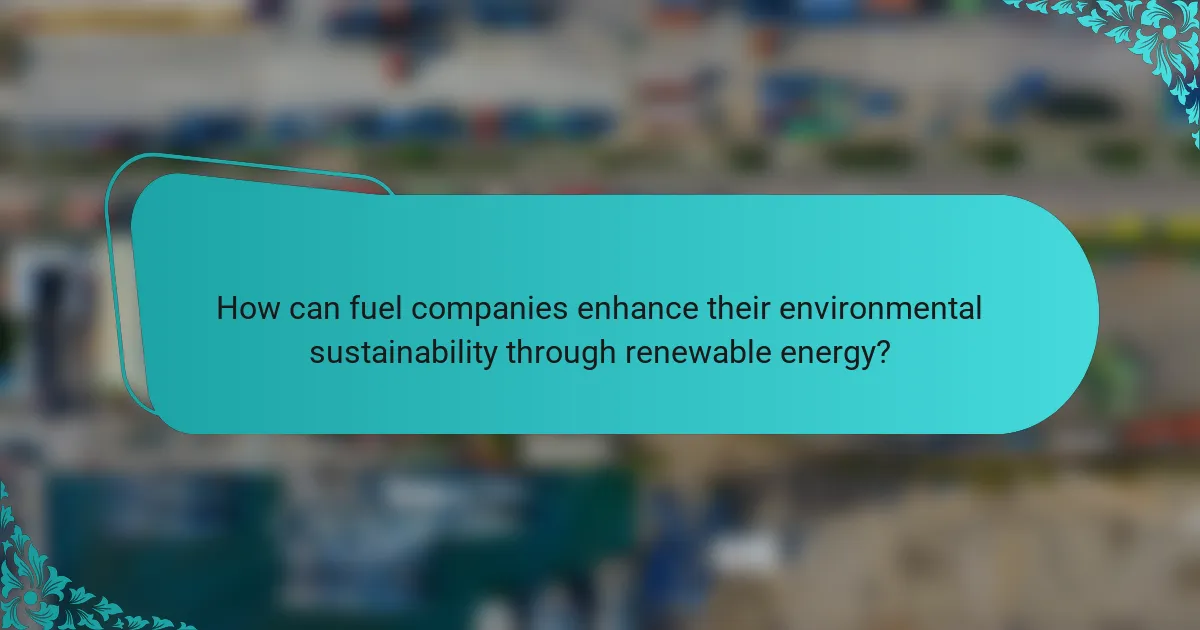
How can fuel companies enhance their environmental sustainability through renewable energy?
Fuel companies can enhance their environmental sustainability through renewable energy by integrating alternative energy sources into their operations. This includes investing in solar, wind, and bioenergy technologies. By transitioning to these renewable sources, companies can significantly reduce greenhouse gas emissions. For instance, a study by the International Renewable Energy Agency (IRENA) found that solar and wind energy can cut emissions by up to 70% in certain sectors. Additionally, renewable energy can improve energy security and reduce dependence on fossil fuels. Companies that adopt these practices can also benefit from government incentives and subsidies aimed at promoting clean energy. Overall, embracing renewable energy is a strategic move for fuel companies to achieve sustainability goals while maintaining competitiveness in a changing market.
What best practices can fuel companies adopt for renewable energy integration?
Fuel companies can adopt several best practices for renewable energy integration. First, they should conduct a comprehensive energy audit to assess current energy usage. This helps identify areas where renewable energy can be effectively implemented. Second, companies should establish partnerships with renewable energy providers. Collaborating with experts can facilitate access to the latest technologies and innovations. Third, investing in energy storage solutions is crucial. These solutions enable companies to store excess energy generated from renewable sources for later use.
Additionally, companies should implement smart grid technologies. Smart grids enhance energy management and improve efficiency in energy distribution. Another best practice is to set measurable sustainability goals. Clear targets can drive accountability and track progress in renewable energy adoption. Lastly, ongoing employee training is essential. Educating staff on renewable energy technologies ensures effective implementation and operation.
These practices not only support renewable energy integration but also contribute to reducing the environmental impact of fuel companies.
How can fuel companies measure the effectiveness of renewable energy initiatives?
Fuel companies can measure the effectiveness of renewable energy initiatives through key performance indicators (KPIs). These KPIs may include reductions in greenhouse gas emissions and increases in renewable energy usage. Tracking the percentage of energy sourced from renewables provides direct insight into progress. Additionally, companies can assess cost savings associated with renewable energy investments. Analyzing customer adoption rates of renewable products also indicates market acceptance. Surveys can gauge public perception of the company’s sustainability efforts. Benchmarking against industry standards offers context for performance evaluation. Regular reporting ensures transparency and accountability in renewable initiatives. These methods collectively enable fuel companies to quantify the impact of their renewable energy strategies.
What partnerships can fuel companies form to promote renewable energy usage?
Fuel companies can form partnerships with renewable energy developers to promote renewable energy usage. Collaborating with solar and wind energy firms can enhance access to clean energy sources. These partnerships can lead to joint projects that increase renewable energy production. Fuel companies can also partner with government agencies for incentives and funding opportunities. Working with research institutions can drive innovation in renewable technologies. Collaborations with NGOs can raise awareness about renewable energy benefits. Partnerships with other corporations can lead to shared resources and expertise. Such alliances can ultimately help reduce carbon emissions and promote sustainability.
What are the future trends in renewable energy for fuel companies?
Future trends in renewable energy for fuel companies include increased investment in solar and wind energy. Companies are shifting towards sustainable practices to reduce carbon emissions. The global renewable energy market is expected to grow significantly, projected to reach $2 trillion by 2025. Innovations in energy storage technology are enhancing the viability of renewable sources. Fuel companies are also exploring biofuels and hydrogen as alternative energy sources. Governments are implementing stricter regulations to promote clean energy adoption. Collaboration between fuel companies and technology firms is becoming more common. The transition to renewable energy is crucial for meeting climate goals and ensuring energy security.
How will advancements in technology shape the future of renewable energy in the fuel sector?
Advancements in technology will significantly enhance the efficiency and accessibility of renewable energy in the fuel sector. Innovations in solar panel efficiency have improved energy capture rates by over 20% in recent years. Wind turbine technology has also advanced, with larger turbines generating more power at lower wind speeds. Energy storage solutions, such as lithium-ion batteries, are becoming cheaper and more effective, enabling better integration of renewable sources. Smart grid technology allows for improved energy distribution and management, reducing waste and optimizing usage. According to the International Renewable Energy Agency, the cost of renewable energy technologies has fallen dramatically, making them more competitive with fossil fuels. These advancements will drive greater adoption of renewable energy, leading to reduced carbon emissions and a more sustainable fuel sector.
What role will policy changes play in the future of renewable energy adoption by fuel companies?
Policy changes will significantly accelerate renewable energy adoption by fuel companies. Regulations promoting cleaner energy sources will incentivize investment in renewables. For instance, carbon pricing can make fossil fuels less economically viable. Additionally, subsidies for renewable technologies lower the financial barriers for companies. Mandates for renewable energy usage will compel companies to diversify their energy portfolios. Countries like Germany have seen increased renewable adoption due to supportive policy frameworks. Historical data shows that policy shifts can lead to a substantial increase in renewable energy capacity. Therefore, effective policy changes are crucial for the transition to sustainable energy practices in the fuel industry.
What practical steps can fuel companies take to transition to renewable energy?
Fuel companies can transition to renewable energy by investing in solar and wind power technologies. They should conduct feasibility studies to identify suitable sites for renewable energy installations. Collaborating with technology providers can enhance access to advanced renewable solutions.
Additionally, companies can diversify their energy portfolios by integrating biofuels and hydrogen into their offerings. Implementing energy efficiency measures within operations will reduce overall energy consumption.
Training employees on renewable energy practices is essential for successful implementation. Establishing partnerships with governments and organizations can facilitate funding and support for renewable projects.
According to the International Energy Agency, renewable energy sources accounted for nearly 30% of global electricity generation in 2020, demonstrating the viability of this transition.
The primary entity of this article is the environmental impact of renewable energy sources in fuel companies. The article outlines how renewable energy significantly reduces greenhouse gas emissions and pollution compared to fossil fuels, highlighting specific sources such as solar, wind, and biofuels. It discusses the economic advantages of integrating renewables, including cost savings and improved public perception, while also addressing challenges like initial investment costs and regulatory hurdles. Additionally, the article explores best practices for renewable energy adoption and future trends, emphasizing the role of technology and policy changes in facilitating this transition.
